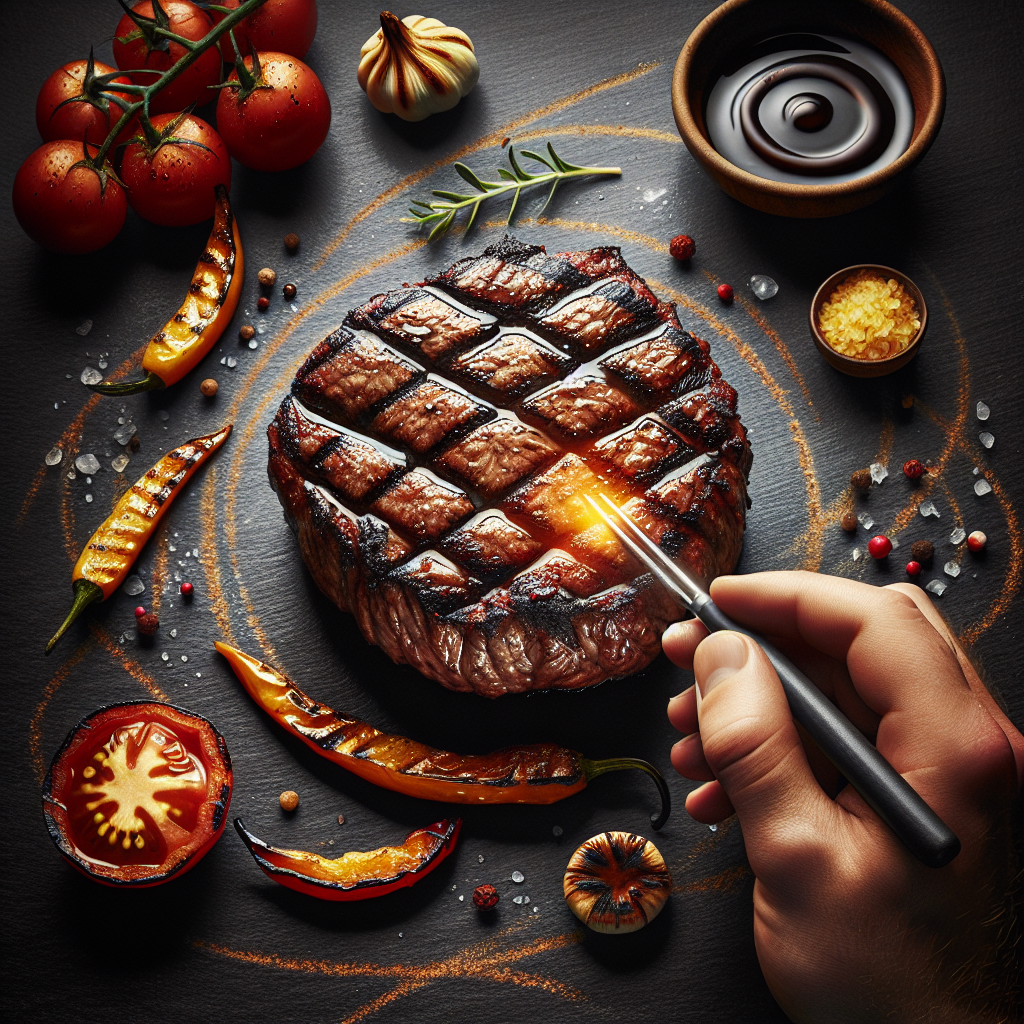Knowing when your meat is perfectly cooked on the grill can be a daunting task, but fear not! In this article, we will guide you through the different methods to determine if your meat is done grilling. From using a meat thermometer to relying on touch and visual cues, we will provide you with all the tips and tricks you need to confidently serve up deliciously cooked meat every time. So, whether you’re a seasoned grilling pro or a novice in the world of barbecues, read on to learn how to achieve that perfect doneness and impress your friends and family with your grilling mastery.

Visual cues
Grilling meat to perfection involves more than just cooking it for a certain amount of time. Visual cues play a crucial role in determining when your meat is done to your liking. There are four key visual cues to look out for: color, texture, juices, and internal temperature.
Color
Color can be a reliable indicator of doneness when grilling different types of meat. Let’s explore the various colors to look for in different meats:
Beef
When grilling beef, you’ll notice a range of colors depending on your preferred level of doneness. Here are some general guidelines:
- Rare: The center of the meat will have a bright red color with a seared brown exterior.
- Medium-rare: The center will have a warm pink color and a nicely browned exterior.
- Medium: The center will be pinkish-brown, while the exterior will have a deep brown crust.
- Medium-well: The center will be slightly pink, transitioning into more of a grayish-brown color. The exterior will have a dark brown crust.
- Well done: The center will be mostly gray or brown, with little to no pink. The exterior will have a dark brown to black crust.
Poultry
Poultry, such as chicken, turkey, and duck, have different color indicators for doneness:
- Chicken: For fully cooked chicken, the meat should have a crisp, golden-brown skin, and the juices should run clear when pierced with a fork. The internal temperature should reach 165°F (74°C).
- Turkey: A perfectly cooked turkey will have a browned skin and the internal temperature should reach 165°F (74°C).
- Duck: The skin of a well-cooked duck will be crisp, golden-brown, and the internal temperature should range from 140°F (60°C) for medium-rare to 165°F (74°C) for well done.
Pork
When grilling pork, you’ll also rely on color cues to determine doneness:
- Internal temperature: The internal temperature of pork should reach 145°F (63°C) for medium-rare, 160°F (71°C) for medium, or 165°F (74°C) for well done.
- Color: The meat should have a pink hue that transitions into a white or light gray color throughout. The exterior should be browned and caramelized.
Fish
Fish is a delicate protein that requires careful monitoring to achieve the perfect doneness:
- Internal temperature: Different varieties of fish have different target internal temperatures. For example, salmon is typically cooked to medium-rare with an internal temperature of 125°F (52°C). It should be opaque but still moist, easily flaking with a fork.
- Flakey texture: Grilled fish should have a moist, flakey texture, making it easy to separate with a fork.
Texture
Texture is another important factor to consider when determining if your meat is done grilling. The texture of meat can provide valuable information about its doneness.
Firmness
Grilled meat should have a firmness that is appropriate for its doneness level. Gently press on the meat with a pair of tongs or your fingertips to assess its firmness.
Resilience
Resilience refers to how quickly the meat springs back after being pressed. When meat is cooked to your desired level of doneness, it should spring back fairly quickly. However, if it feels too firm or doesn’t bounce back, it may be overcooked.
Juices
Juices are not only delicious, but they also provide important clues about the doneness of your meat. Pay attention to the color and amount of juices to determine when your meat is done grilling.
Clear vs. pink
When you first start grilling the meat, the juices may appear pinkish. As the meat cooks, however, the juices should gradually turn clear. Clear juices are an indication that the meat is reaching its desired level of doneness.
Amount of juices
The amount of juices that flow out of the meat can also provide valuable information. If the meat oozes a significant amount of juices, it’s a sign that it may still be undercooked. On the other hand, if the juices are minimal, it could be an indication that the meat is nearing its desired level of doneness.
Internal temperature
While visual cues, color, texture, and juices are crucial, using a meat thermometer is the most reliable way to ensure your meat is cooked to your preferred doneness.
Thermometer usage
To use a meat thermometer, insert the probe into the thickest part of the meat, away from any bones, and wait for the reading to stabilize. Be careful not to touch bone or gristle, as this can give inaccurate results.
Temperature guidelines
Different types of meat have different internal temperature guidelines:
- Beef: For rare beef, the internal temperature should be around 125°F (52°C), while medium-rare should reach 135°F (57°C), medium at 145°F (63°C), medium-well at 150°F (65°C), and well done at 160°F (71°C).
- Poultry: Chicken should reach an internal temperature of 165°F (74°C), turkey should also reach 165°F (74°C), and duck should have an internal temperature ranging from 140°F (60°C) to 165°F (74°C) depending on the desired level of doneness.
- Pork: The recommended internal temperature for pork is 145°F (63°C) for medium-rare, 160°F (71°C) for medium, and 165°F (74°C) for well done.
- Fish: Different varieties of fish have specific target temperatures. Salmon, for example, is typically cooked to 125°F (52°C) for medium-rare.
Kinds of meat
Now that we have covered the visual cues and internal temperatures, let’s take a closer look at the recommended grilling techniques for different kinds of meat.
Beef
Beef comes in various cuts and is often a popular choice for grilling. Here are some key points to consider for different levels of doneness:
- Rare: For those who prefer a juicy, red center, grill your beef for a shorter amount of time. Aim for an internal temperature of around 125°F (52°C).
- Medium-rare: This is the sweet spot for many steak lovers. Aim for an internal temperature of 135°F (57°C) for a warm pink center.
- Medium: For a slightly more cooked center with a hint of pink, aim for an internal temperature of 145°F (63°C).
- Medium-well: This level of doneness is ideal for those who want a slightly pink center to their meat. Aim for an internal temperature of 150°F (65°C).
- Well done: If you prefer your beef fully cooked and without any pink, aim for an internal temperature of 160°F (71°C).
Poultry
Grilling poultry to perfection requires attention to internal temperature and color cues. Here are some tips for grilling common types of poultry:
- Chicken: To ensure safe consumption, the internal temperature of grilled chicken should reach 165°F (74°C). The skin should have a golden-brown color, and when pierced with a fork, the juices should run clear.
- Turkey: Whether grilling a whole turkey or turkey breasts, the internal temperature should also reach 165°F (74°C) for safe consumption. The skin should be beautifully browned, and the meat should be juicy and tender.
- Duck: When grilling duck, the internal temperature should range between 140°F (60°C) for medium-rare and 165°F (74°C) for well done. The skin should be crisp and golden-brown, while the meat should be succulent and flavorful.
Pork
Pork is a versatile meat that can be grilled to a variety of levels of doneness. However, it’s important to cook pork to its recommended internal temperature to ensure it is safe to consume:
- Internal temperature: The ideal internal temperature for pork is 145°F (63°C) for medium-rare, 160°F (71°C) for medium, and 165°F (74°C) for well done.
- Color: While grilling pork, pay attention to the color change from pink to white or light gray. The exterior should have a browned and caramelized appearance, indicating a delicious crust.
Fish
Grilled fish is a healthy and flavorful choice for BBQ enthusiasts. To achieve the perfect flakey texture and taste, follow these guidelines:
- Internal temperature: The appropriate internal temperature for fish varies depending on the variety. For example, salmon is typically cooked to medium-rare at 125°F (52°C). The fish should be opaque but still moist and should easily flake with a fork.
- Flakey texture: Grilled fish should have a moist, flakey texture. Avoid overcooking to prevent the fish from becoming dry and rubbery.
By paying attention to visual cues such as color, texture, juices, and internal temperature, you can confidently grill different types of meat to your desired level of doneness. Remember, practice makes perfect, and with time and experience, you’ll become a master of grilling succulent meats that your friends and family will rave about. Happy grilling!

